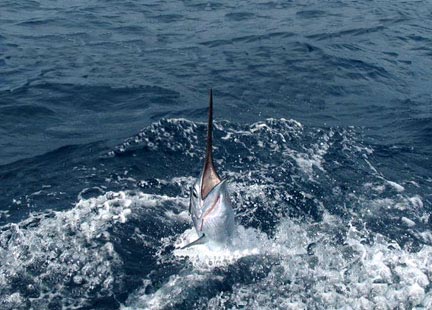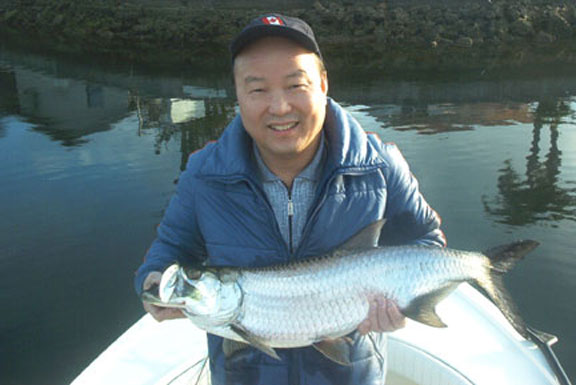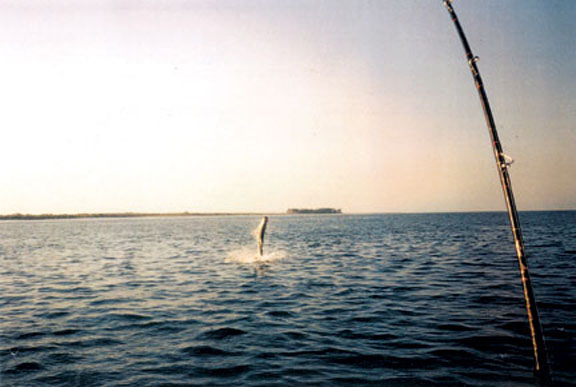|
While
Florida is often not associated with seasons, we do have them. When Old
Man Winter comes to town, our fishing always remains great, but out
catching varies. During the periods of prolonged cold, our neo-tropical
fish may scatter or they may congregate in winter spas. Sometimes they
can be difficult to find. Other times when found they won’t eat, or they might be
stacked like cordwood eating the bottom out of the boat. These are
typical scenarios in the doldrums of winter and we’ve experienced of
share of each one of them this winter season.
| It has long been a tradition of mine to find some personal time
of tranquility by traveling to the East Coast to livebait fish the
natural phenomenon of the massing of sailfish in the Gulf Stream
during the coldest days of winter. The deep cobalt and warm waters
of the Gulf Stream pass close by the coast from just 4 to 9 miles
offshore. I find little more relaxing than flying fishing kites
and dangling livebaits while drifting the edges, breaks, eddies,
rips and weed lines of the Gulf Stream. The fishing is often best
the days after a passing cold front and the subsequent northerly
winds. The winds were high and the seas were big for the better
part of the peak run in 2005. This variable limited both the
number of days I could get out and too where I could go. We had
some decent days this winter, but it was not like years past where
double digits were typical in the areas that are within a
reasonable distance from my home.
It did not matter to me as the sea once again offered me
the great escape of serenity, peace and solitude. As
Hemmingway’s character “Santiago” did, I too “dreamed
about lions” and how good it is to be alive. |

The big sail bite
was to the south this year, but as long as
I could "dream
about lions", I found peace :-)
|
|

World class fly fisher and
gentleman Andre Padovani of British Columbia with one of several reds he took on fly last week.
|
Back home, the trout bite has been red
hot. In the deeper grass flats adjacent to the ICW, school-sized
trout are cumulus. Underneath the flocks of birds in the same areas,
bluefish and ladyfish are wreaking havoc on the baits.
Jigs and
topwater lures get the nod for the trout, ladyfish and bluefish.
During the warming trends, the monster trout are massed up on
the shallow flats, oyster bars, creek mouths and bends, cul-de-sacs
and in shallow swashes and potholes around mangrove lined barrier
islands. In the same areas, we are also having success with redfish.
Winter reds are notorious for hanging around riprap, oyster
bars, and rock piles catching some rays at the top of the flood
tide. At low tide, I have
been finding a few “tailing” on
the grass flats adjacent to deep water. Soft plastic jerk worms
or eels are producing well in these areas on both the “gator”
trout and the redfish.
|
|
Fly anglers are having
best success with brown and white Lefty Deceivers and green
clouser minnows.
Off the shore of the
Anclote Power Plant, jumbo jacks and few pompano are working the flats
on the warm days following the cold fronts. Marauding jacks just can’t
refuse a noisy topwater plug and the pompano are suckers for
shrimp-tipped “banana” jigs.
Deep in the backwaters, juvenile tarpon and a few
snook have obliged to our offerings on the tide changes. Juvenile
tarpon and snook are very sensitive to the cooler waters as they
are sub-tropical and, not to mention, the most temperamental
species in Florida waters. With some patience, on most days
we’ve gotten them to eat jigs and live jumbo shrimp.
|

Paul Chan
proudly displays a juvenile tarpon that fell prey to his chartreuse
green tail and read head jig on a recent chilly morning. |
The weather forecast for the week is highs in the upper 70s and
lows in the mid 50s. While a late season blast of air is always
possible in mid February, I have noticed a significant increase in
activity with all of the fish the past week. Mother Nature and
Father Time are playing tug of war. Father Time is gaining the
upper hand, as our days grow longer with each passing. It is still
a little early, but it won’t be much longer now before spring
has sprung and the pinnacle flats fishing will occur.
In the coming weeks, the
grouper bite will improve closer to shore. Cobia will first show on the
deeper structures. Shortly thereafter, they will be found riding the
backs of large Southern stingrays and make excellent sight casting
prospects. St. Patrick’s Day is the mile marker for the appearance of
permit, Spanish mackerel and king mackerel. The arrival of the mackerel
will in turn aid in pushing the staple scaled sardines to the flats. For
those in the know of the whereabouts of the earliest arrival of the
crickets, they (we) will experience a version of Florida fishing
pandemonium found at no other time of year.
At this time, water
temperatures are hovering around 64 degrees. When we hit the benchmark
of 68 to 70, the first of the giant tarpon will sneak into the deeper
water of the larger bays and rivers. The vernal equinox (even hours of
daylight to darkness) occurs on March 20th, which will be
immediately followed by a full moon on March 25th. With a little
temperate weather, some consistent giant tarpon will likely be found
starting at that time and in those places.
|

Morning has broken in tarpon
country
|
Giant tarpon will
be the quest of those who hail from all parts of the world wishing
to test their mettle against the greatest, big game fish on earth.
Each year tens of thousands of tarpon congregate along our coast
in numbers second to none in the world. The beauty of this
fascinating species is its character traits of purity and
non-discrimination. Unlike other big game fish, tarpon inhabit
areas close to land that are accessible by million dollar yachts,
wooden row boats, or merely from a fishing pier. They care not of
what class of society you come from. They are not reserved for
social drifting during martini hour, Grey Poupon and fine Cuban
cigars. They like you just the same if you drink Busch beer, enjoy
Vienna hot dogs and chew Copenhagen. They care less if you offer
them live, dead, or artificial bait. They will burn the gears of a
Penn International reel just as they will a Zebco Rhino. Tarpon
are American built.
|
|
|



![]()
![]() Send E-Mail
Send E-Mail
![]()